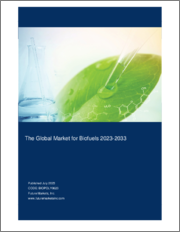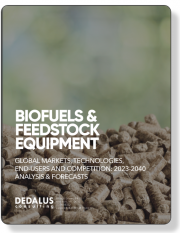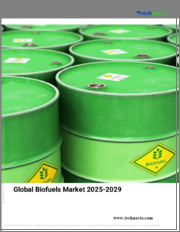
|
시장보고서
상품코드
1311210
세계의 바이오연료 시장(2023-2033년)The Global Market for Biofuels 2023-2033 |
||||||
세계의 바이오연료 시장에 대해 조사분석했으며, 시장 촉진요인과 동향, 바이오연료 소비의 예측, 기업 개요 등을 제공하고 있습니다.
목차
제1장 조사 방법
제2장 주요 요약
- 화석연료와의 비교
- 순환경제에서의 역할
- 시장 촉진요인
- 시장이 해결해야 할 과제
- 액체 바이오연료 시장 : 유형별, 생산별(2020-2033년)
제3장 산업의 발전(2020년-)
제4장 바이오연료
- 세계의 바이오연료 시장
- 디젤 대체품
- 가솔린 대체품
- SWOT 분석 : 바이오연료 시장
- 바이오연료 비용의 비교 : 유형별(2023년)
- 유형
- 고체 바이오연료
- 액체 바이오연료
- 기체 바이오연료
- 기존 바이오연료
- 첨단 바이오연료
- 원료
- 제1세대(1-G)
- 제2세대(2-G)
- 제3세대(3-G)
- 제4세대(4-G)
- 장단점 : 세대별
- 에너지 작물
- 농업잔류물
- 분뇨, 하수 오니, 유기 폐기물
- 임업, 목재 폐기물
- 원료 비용
제5장 탄화수소 바이오연료
- 바이오디젤
- 바이오디젤 : 세대별
- SWOT 분석
- 바이오디젤과 기타 바이오연료 생산
- 가격
- 세계의 생산과 소비
- 재생 디젤
- 생산
- SWOT 분석
- 세계의 소비
- 가격
- 바이오 항공 연료(바이오 제트 연료, 지속가능한 항공 연료, 재생 제트 연료 또는 항공 바이오연료)
- 개요
- SWOT 분석
- 세계의 생산과 소비
- 생산 경로
- 가격
- 바이오 항공 연료 생산능력
- 과제
- 세계의 소비
- 바이오 나프타
- 개요
- SWOT 분석
- 시장과 용도
- 가격
- 생산능력 : 제조업체별, 현행과 계획중
- 생산능력, 합계, 실적, 현행과 계획중
제6장 알코올 연료
- 바이오 메탄올
- SWOT 분석
- 메탄올로부터 가솔린에 대한 기술
- 에탄올
- 기술 설명
- 1G 바이오에탄올
- SWOT 분석
- 에탄올로부터 제트 연료에 대한 기술
- 종이·펄프 생산으로부터의 메탄올
- 아황산 폐액 발효
- 가스화
- CO2 회수와 알코올 합성
- 바이오매스 가수분해와 발효
- 세계의 에탄올 소비
- 바이오부탄올
- 생산
- 가격
제7장 바이오매스 기반 가스
- 원료
- 바이오가스
- 바이오메탄
- 생산 경로
- SWOT 분석
- 세계의 생산
- 가격
- 바이오 LNG
- bio-CNG(바이오가스 유래 압축천연가스)
- 바이오가스로부터의 탄소 포집
- 바이오 합성가스
- 생산
- 가격
- 바이오 수소
- 개요
- SWOT 분석
- 바이오매스로부터의 바이오 수소 생산
- 용도
- 가격
- 바이오가스 생산에서의 바이오차
- 바이오 DME
제8장 바이오연료용 케미컬 재활용
- 플라스틱 열분해
- 사용 종료 타이어 열분해
- 바이오연료로의 전환
- 바이오매스와 플라스틱 폐기물의 공열분해
- 가스화
- 합성가스 메탄올로의 변환
- 바이오매스 가스화와 합성가스 발효
- 바이오매스 가스화와 합성가스 열화학 변환
- 열수 가열 분해
- SWOT 분석
제9장 합성연료(e-fuel)
- 서론
- 합성연료(e-fuel)의 이점
- 원료
- 수소 전해
- CO2 회수
- SWOT 분석
- 생산
- 합성연료(e-fuel) 생산 시설, 현행과 계획중
- 전해조
- 상업용 알칼리 전해 셀(AEC)
- PEM 전해조(PEMEC)
- 고온 고체 산화물 전해 셀(SOEC)
- 가격
- 시장이 해결해야 할 과제
- 기업
제10장 조류 유래 바이오연료
- 기술 설명
- 변환 경로
- SWOT 분석
- 생산
- 시장이 해결해야 할 과제
- 가격
- 제조업체
제11장 그린 암모니아
- 생산
- 암모니아 생성의 탈탄소화
- 그린 암모니아 프로젝트
- 그린 암모니아 합성법
- 하버 보슈법
- 생물학적 질소 고정
- 전기화학 생산
- 케미컬 루핑법
- SWOT 분석
- 블루 암모니아
- 블루 암모니아 프로젝트
- 시장과 용도
- 화학에너지 저장
- 선박용 연료
- 가격
- 추정 시장 수요
- 기업과 프로젝트
제12장 탄소 포집 유래 바이오연료
- 개요
- 점원으로부터의 CO2 회수
- 생산 루트
- SWOT 분석
- 직접 공기 회수(DAC)
- 개요
- 도입
- 점원 탄소 포집과 직접 공기 회수
- 기술
- 상품화와 공장
- DAC 금속 유기 구조체(MOF)
- DAC 플랜트와 프로젝트 - 현행과 계획중
- DAC 시장
- 비용
- 과제
- 기업과 생산
- 메탄올
- 조류 기반 탄소 이용
- 태양광로부터의 CO2 연료
- 기업
- 과제
제13장 바이오 오일(열분해유)
- 개요
- 바이오 오일의 이점
- 생산
- 고속 열분해
- 생산비용
- 업그레이드
- SWOT 분석
- 용도
- 바이오 오일 제조업체
- 가격
제14장 폐기물 재생 연료(RDF)
- 개요
- 생산
- 생산 공정
- 기계 생물학 처리
- 시장
제15장 기업 개요(198사의 개요)
제16장 참고 재료
KSA 23.09.14Biofuels are renewable transportation fuels derived from organic material including crops, agricultural residues, and waste. There has been a huge growth in the production and usage of biofuels as substitutes for fossil fuels. Due to the declining reserve of fossil resources as well as environmental concerns, and essential energy security, it is important to develop renewable and sustainable energy and chemicals.
The use of biofuels manufactured from plant-based biomass as feedstock would reduce fossil fuel consumption and consequently the negative impact on the environment. Renewable energy sources cover a broad raw material base, including cellulosic biomass (fibrous and inedible parts of plants), waste materials, algae, and biogas.
“The Global Market for Biofuels 2023-2023”, now in its Third Edition (first published June 2022), covers bio-based fuels based on utilization of:
- First-Generation Feedstocks (food-based) e.g. Waste oils including used cooking oil, animal fats, and other fatty acids.
- Second-Generation Feedstocks (non-food based) e.g. Lignocellulosic wastes and residues, Energy crops, Agricultural residues, Forestry residues, Biogenic fraction of municipal and industrial waste.
- Third-Generation Feedstocks e.g. algal biomass
- Fourth-Generation Feedstocks e.g. genetically modified (GM) algae and cyanobacteria.
Report contents include:
- Market trends and drivers.
- Market challenges.
- Biofuels pricing analysis.
- Biofuel consumption to 2033.
- SWOT analysis, by feedstock and biofuel type.
- Recent industry developments, innovations and investments.
- Market analysis including key players, end use markets, production processes, costs, production capacities, market demand for biofuels including:
- biodiesel
- renewable diesel
- bio-jet fuels
- bio-naphtha
- biomethanol
- ethanol
- biobutanol
- biogas
- biosyngas
- biohydrogen
- biofuel from plastic waste & used tires
- biofuels from carbon capture
- chemical recycling based biofuels
- electrofuels,
- bio-oils
- algae-derived biofuels
- green ammonia
- refuse-derived biofuels.
- Production and synthesis methods.
- 198 company profiles. Companies profiled include BTG Bioliquids, Byogy Renewables, Caphenia, Enerkem, Infinium. Eni S.p.A., Ensyn, FORGE Hydrocarbons Corporation, Fulcrum Bioenergy, Genecis Bioindustries, Gevo, Haldor Topsoe, Infinium Electrofuels, Opera Bioscience, Reverion GmbH, Steeper Energy, SunFire GmbH, Vertus Energy and Viridos, Inc.
TABLE OF CONTENTS
1 RESEARCH METHODOLOGY
2 EXECUTIVE SUMMARY
- 2.1 Comparison to fossil fuels
- 2.2 Role in the circular economy
- 2.3 Market drivers
- 2.4 Market challenges
- 2.5 Liquid biofuels market 2020-2033, by type and production
3 INDUSTRY DEVELOPMENTS 2020-
4 BIOFUELS
- 4.1 The global biofuels market
- 4.1.1 Diesel substitutes and alternatives
- 4.1.2 Gasoline substitutes and alternatives
- 4.2 SWOT analysis: Biofuels market
- 4.3 Comparison of biofuel costs 2023, by type
- 4.4 Types
- 4.4.1 Solid Biofuels
- 4.4.2 Liquid Biofuels
- 4.4.3 Gaseous Biofuels
- 4.4.4 Conventional Biofuels
- 4.4.5 Advanced Biofuels
- 4.5 Feedstocks
- 4.5.1 First-generation (1-G)
- 4.5.2 Second-generation (2-G)
- 4.5.2.1 Lignocellulosic wastes and residues
- 4.5.2.2 Biorefinery lignin
- 4.5.3 Third-generation (3-G)
- 4.5.3.1 Algal biofuels
- 4.5.4 Fourth-generation (4-G)
- 4.5.5 Advantages and disadvantages, by generation
- 4.5.6 Energy crops
- 4.5.6.1 Feedstocks
- 4.5.6.2 SWOT analysis
- 4.5.7 Agricultural residues
- 4.5.7.1 Feedstocks
- 4.5.7.2 SWOT analysis
- 4.5.8 Manure, sewage sludge and organic waste
- 4.5.8.1 Processing pathways
- 4.5.8.2 SWOT analysis
- 4.5.9 Forestry and wood waste
- 4.5.9.1 Feedstocks
- 4.5.9.2 SWOT analysis
- 4.5.10 Feedstock costs
5 HYDROCARBON BIOFUELS
- 5.1 Biodiesel
- 5.1.1 Biodiesel by generation
- 5.1.2 SWOT analysis
- 5.1.3 Production of biodiesel and other biofuels
- 5.1.3.1 Pyrolysis of biomass
- 5.1.3.2 Vegetable oil transesterification
- 5.1.3.3 Vegetable oil hydrogenation (HVO)
- 5.1.3.4 Biodiesel from tall oil
- 5.1.3.5 Fischer-Tropsch BioDiesel
- 5.1.3.6 Hydrothermal liquefaction of biomass
- 5.1.3.7 CO2 capture and Fischer-Tropsch (FT)
- 5.1.3.8 Dymethyl ether (DME)
- 5.1.4 Prices
- 5.1.5 Global production and consumption
- 5.2 Renewable diesel
- 5.2.1 Production
- 5.2.2 SWOT analysis
- 5.2.3 Global consumption
- 5.2.4 Prices
- 5.3 Bio-aviation fuel (bio-jet fuel, sustainable aviation fuel, renewable jet fuel or aviation biofuel)
- 5.3.1 Description
- 5.3.2 SWOT analysis
- 5.3.3 Global production and consumption
- 5.3.4 Production pathways
- 5.3.5 Prices
- 5.3.6 Bio-aviation fuel production capacities
- 5.3.7 Challenges
- 5.3.8 Global consumption
- 5.4 Bio-naphtha
- 5.4.1 Overview
- 5.4.2 SWOT analysis
- 5.4.3 Markets and applications
- 5.4.4 Prices
- 5.4.5 Production capacities, by producer, current and planned
- 5.4.6 Production capacities, total (tonnes), historical, current and planned
6 ALCOHOL FUELS
- 6.1 Biomethanol
- 6.1.1 SWOT analysis
- 6.1.2 Methanol-to gasoline technology
- 6.1.2.1 Production processes
- 6.2 Ethanol
- 6.2.1 Technology description
- 6.2.2 1G Bio-Ethanol
- 6.2.3 SWOT analysis
- 6.2.4 Ethanol to jet fuel technology
- 6.2.5 Methanol from pulp & paper production
- 6.2.6 Sulfite spent liquor fermentation
- 6.2.7 Gasification
- 6.2.7.1 Biomass gasification and syngas fermentation
- 6.2.7.2 Biomass gasification and syngas thermochemical conversion
- 6.2.8 CO2 capture and alcohol synthesis
- 6.2.9 Biomass hydrolysis and fermentation
- 6.2.9.1 Separate hydrolysis and fermentation
- 6.2.9.2 Simultaneous saccharification and fermentation (SSF)
- 6.2.9.3 Pre-hydrolysis and simultaneous saccharification and fermentation (PSSF)
- 6.2.9.4 Simultaneous saccharification and co-fermentation (SSCF)
- 6.2.9.5 Direct conversion (consolidated bioprocessing) (CBP)
- 6.2.10 Global ethanol consumption
- 6.3 Biobutanol
- 6.3.1 Production
- 6.3.2 Prices
7 BIOMASS-BASED GAS
- 7.1 Feedstocks
- 7.2 Biogas
- 7.2.1 Biomethane
- 7.2.2 Production pathways
- 7.2.2.1 Landfill gas recovery
- 7.2.2.2 Anaerobic digestion
- 7.2.2.3 Thermal gasification
- 7.2.3 SWOT analysis
- 7.2.4 Global production
- 7.2.5 Prices
- 7.2.5.1 Raw Biogas
- 7.2.5.2 Upgraded Biomethane
- 7.2.6 Bio-LNG
- 7.2.6.1 Markets
- 7.2.6.2 Production
- 7.2.6.3 Plants
- 7.2.7 bio-CNG (compressed natural gas derived from biogas)
- 7.2.8 Carbon capture from biogas
- 7.3 Biosyngas
- 7.3.1 Production
- 7.3.2 Prices
- 7.4 Biohydrogen
- 7.4.1 Description
- 7.4.2 SWOT analysis
- 7.4.3 Production of biohydrogen from biomass
- 7.4.3.1 Biological Conversion Routes
- 7.4.3.2 Thermochemical conversion routes
- 7.4.4 Applications
- 7.4.5 Prices
- 7.5 Biochar in biogas production
- 7.6 Bio-DME
8 CHEMICAL RECYCLING FOR BIOFUELS
- 8.1 Plastic pyrolysis
- 8.2 Used tires pyrolysis
- 8.2.1 Conversion to biofuel
- 8.3 Co-pyrolysis of biomass and plastic wastes
- 8.4 Gasification
- 8.4.1 Syngas conversion to methanol
- 8.4.2 Biomass gasification and syngas fermentation
- 8.4.3 Biomass gasification and syngas thermochemical conversion
- 8.5 Hydrothermal cracking
- 8.6 SWOT analysis
9 ELECTROFUELS (E-FUELS)
- 9.1 Introduction
- 9.1.1 Benefits of e-fuels
- 9.2 Feedstocks
- 9.2.1 Hydrogen electrolysis
- 9.2.2 CO2 capture
- 9.3 SWOT analysis
- 9.4 Production
- 9.4.1 eFuel production facilities, current and planned
- 9.5 Electrolysers
- 9.5.1 Commercial alkaline electrolyser cells (AECs)
- 9.5.2 PEM electrolysers (PEMEC)
- 9.5.3 High-temperature solid oxide electrolyser cells (SOECs)
- 9.6 Prices
- 9.7 Market challenges
- 9.8 Companies
10 ALGAE-DERIVED BIOFUELS
- 10.1 Technology description
- 10.2 Conversion pathways
- 10.3 SWOT analysis
- 10.4 Production
- 10.5 Market challenges
- 10.6 Prices
- 10.7 Producers
11 GREEN AMMONIA
- 11.1 Production
- 11.1.1 Decarbonisation of ammonia production
- 11.1.2 Green ammonia projects
- 11.2 Green ammonia synthesis methods
- 11.2.1 Haber-Bosch process
- 11.2.2 Biological nitrogen fixation
- 11.2.3 Electrochemical production
- 11.2.4 Chemical looping processes
- 11.3 SWOT analysis
- 11.4 Blue ammonia
- 11.4.1 Blue ammonia projects
- 11.5 Markets and applications
- 11.5.1 Chemical energy storage
- 11.5.1.1 Ammonia fuel cells
- 11.5.2 Marine fuel
- 11.5.1 Chemical energy storage
- 11.6 Prices
- 11.7 Estimated market demand
- 11.8 Companies and projects
12 BIOFUELS FROM CARBON CAPTURE
- 12.1 Overview
- 12.2 CO2 capture from point sources
- 12.3 Production routes
- 12.4 SWOT analysis
- 12.5 Direct air capture (DAC)
- 12.5.1 Description
- 12.5.2 Deployment
- 12.5.3 Point source carbon capture versus Direct Air Capture
- 12.5.4 Technologies
- 12.5.4.1 Solid sorbents
- 12.5.4.2 Liquid sorbents
- 12.5.4.3 Liquid solvents
- 12.5.4.4 Airflow equipment integration
- 12.5.4.5 Passive Direct Air Capture (PDAC)
- 12.5.4.6 Direct conversion
- 12.5.4.7 Co-product generation
- 12.5.4.8 Low Temperature DAC
- 12.5.4.9 Regeneration methods
- 12.5.5 Commercialization and plants
- 12.5.6 Metal-organic frameworks (MOFs) in DAC
- 12.5.7 DAC plants and projects-current and planned
- 12.5.8 Markets for DAC
- 12.5.9 Costs
- 12.5.10 Challenges
- 12.5.11 Players and production
- 12.6 Methanol
- 12.7 Algae-based carbon utilization
- 12.8 CO2-fuels from solar
- 12.9 Companies
- 12.10 Challenges
13 BIO-OILS (PYROLYSIS OIL)
- 13.1 Description
- 13.1.1 Advantages of bio-oils
- 13.2 Production
- 13.2.1 Fast Pyrolysis
- 13.2.2 Costs of production
- 13.2.3 Upgrading
- 13.3 SWOT analysis
- 13.4 Applications
- 13.5 Bio-oil producers
- 13.6 Prices
14 REFUSE-DERIVED FUELS (RDF)
- 14.1 Overview
- 14.2 Production
- 14.2.1 Production process
- 14.2.2 Mechanical biological treatment
- 14.3 Markets



















